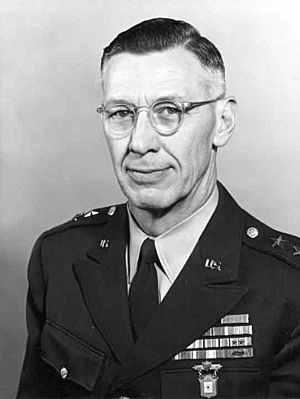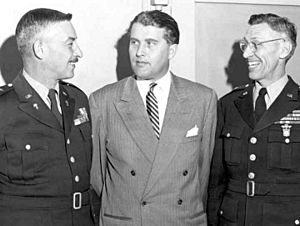Holger Toftoy facts for kids
Quick facts for kids
Holger Toftoy
|
|
|---|---|
 |
|
| Born |
Holger Nelson Toftoy
31 October 1902 Marseilles, Illinois, U.S.
|
| Died | 19 April 1967 (aged 64) Huntsville, Alabama, U.S.
|
| Resting place | Arlington National Cemetery |
| Alma mater | United States Military Academy |
| Occupation | Military officer |
| Military career | |
| Allegiance | |
| Service/ |
|
| Years of service | 1922–1960 |
| Rank | Major general |
| Battles/wars | World War II |
Major General Holger Nelson Toftoy (born October 31, 1902 – died April 19, 1967) was an important officer in the United States Army. He played a huge role in developing America's first rockets after World War II. He helped create missiles like the Redstone missile.
Toftoy convinced top military leaders to bring German scientists to the U.S. after the war. These scientists had amazing knowledge about rockets. He oversaw the move of over 119 scientists to America.
In 1952, he became the director of the Ordnance Missile Laboratories. This was at Redstone Arsenal in Huntsville, Alabama. By 1958, he was a top leader at the Army Ordnance Missile Command. Later that year, he moved to lead the Aberdeen Proving Ground in Maryland. He retired two years later due to health problems and moved to Florida.
Contents
Holger Toftoy's Early Life and Army Career
Holger Toftoy was born on October 31, 1902, in Marseilles, Illinois. He went to local schools when he was young.
He first studied at the University of Wisconsin–Madison. There, he was part of the ROTC program. Later, he transferred to the United States Military Academy (West Point). He graduated from West Point in 1926.
After some basic flight training, he joined the Coast Artillery. He spent three years in Hawaii as a battery commander. Then, he returned to West Point to teach.
In the 1930s, Toftoy was sent to the Panama Canal. His job was to command the defenses for the Pacific side of the canal. In 1938, he moved to the Submarine Mine Depot at Fort Monroe. For six years, he led the Industrial and Research and Development divisions there.
Operation Paperclip: Bringing Scientists to America
While at the Submarine Mine Depot, Toftoy helped create a new system for controlled submarine mines. These mines were used a lot during World War II. Toftoy became an expert in mines and explosives. He even helped clear harbors in France during the war.
In 1944, Toftoy became the head of Army teams in Europe. Their job was to find and check enemy weapons and equipment. During this time, he got an important request. He needed to get 100 working V-2 rockets and send them to White Sands Missile Range in New Mexico for testing.
After the Allies captured areas like Nordhausen, Toftoy started "Special Mission V-2." He put Major William Bromley in charge of this mission. Bromley's job was to ship the rockets from Nordhausen to Antwerp. From Antwerp, they would go to New Orleans and then to White Sands.
Bromley and another officer, Major James P. Hamill, went to central Germany. They had to quickly gather as many missiles as possible. U.S. forces were leaving the area soon. Even though 100 complete V-2s weren't available, Toftoy organized soldiers and workers. They loaded rocket parts onto trains. From May 22 to May 31, several trains left Nordhausen. They were full of missile parts, completing the mission successfully.
Toftoy knew the U.S. Army wanted to add guided missiles to its weapons. He told the Pentagon that German scientists should come to the U.S. to help. This mission became known as Operation Paperclip. By September 1945, the first group of scientists, including Wernher von Braun, arrived in the United States. Under Toftoy's leadership, about 119 German scientists came to the U.S. in the first year. Toftoy then moved to Washington. He was put in charge of the Army's guided missile program.
After the War: Building America's Missile Program

In 1952, Toftoy was sent to Redstone Arsenal in Alabama. He became the director of the Ordnance Missile Laboratories. This group was in charge of planning and overseeing the Army's missile and rocket development program across the country.
During his time there, Redstone Arsenal became responsible for many things. This included researching, developing, buying, making, storing, and maintaining all of the Army's missiles and rockets. Some of the famous missiles from this program included the PGM-19 Jupiter, the MGR-1 Honest John, the LIM-49 Nike Zeus, and the MIM-3 Nike Ajax.
In 1958, Toftoy became the deputy commanding general of the Army Ordnance Missile Command at Redstone Arsenal. He led the Redstone Arsenal until July 1958. Then, in August 1958, he was named the commanding general of Aberdeen Proving Ground in Maryland.
In 1960, Toftoy retired from the army because of health issues. He moved to Treasure Island, Florida. There, he had a private boat landing and could easily go fishing in the Gulf of Mexico. He loved fishing! He also continued to work as a consultant for companies like Northrop Corporation. He became involved in local community groups too. In 1962, he was elected President of the Isle of Capri Civic Association.
Death and Honors
In late 1966, Toftoy became ill again during a visit to his daughter in Huntsville. He was taken to Walter Reed Army Medical Center. He had several operations in the following months. Holger Toftoy passed away on April 19, 1967. He was buried in Arlington National Cemetery with full military honors.
Many places and awards honor Holger Toftoy's contributions:
- Toftoy Hall was dedicated at Redstone Arsenal on November 3, 1967. It used to provide electronics training for soldiers. Now, it houses the Education Center.
- The Ordnance School at Fort Lee also has a Toftoy Hall. This building is for training in armament and electronic maintenance.
- In 1968, a special plaque was placed in Big Spring Park in Huntsville, Alabama. The people of Huntsville had nicknamed him "Mr. Missile." He was also a member of a local Masonic lodge.

